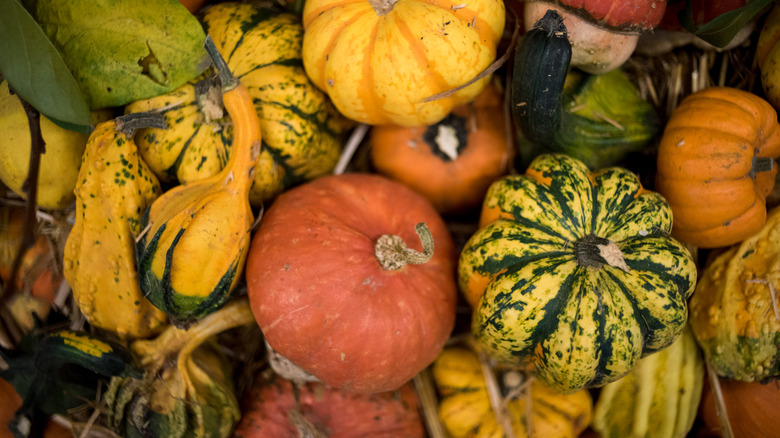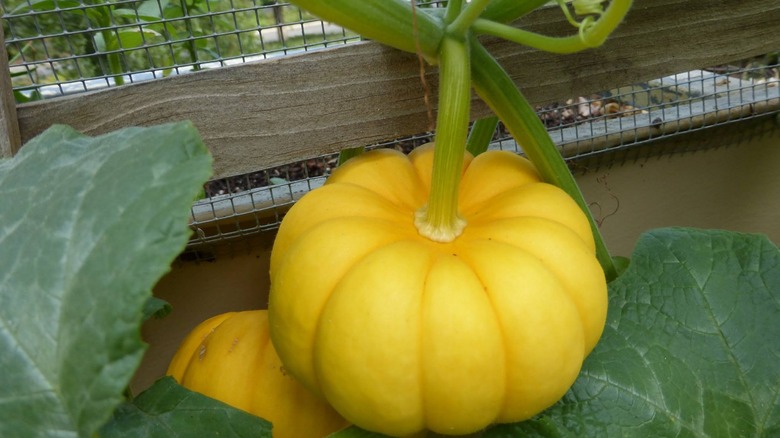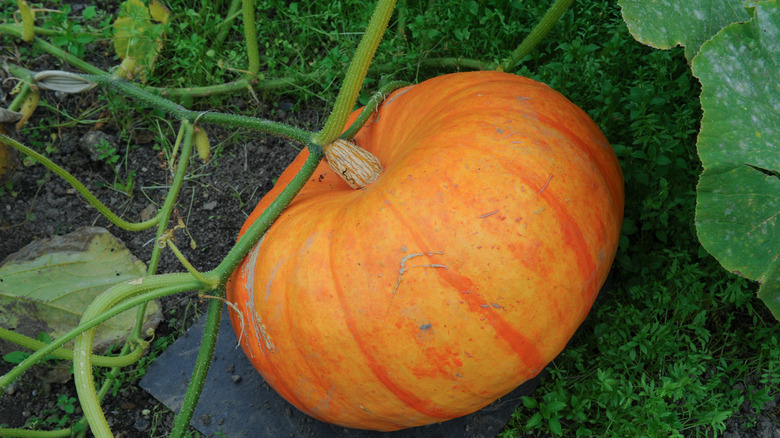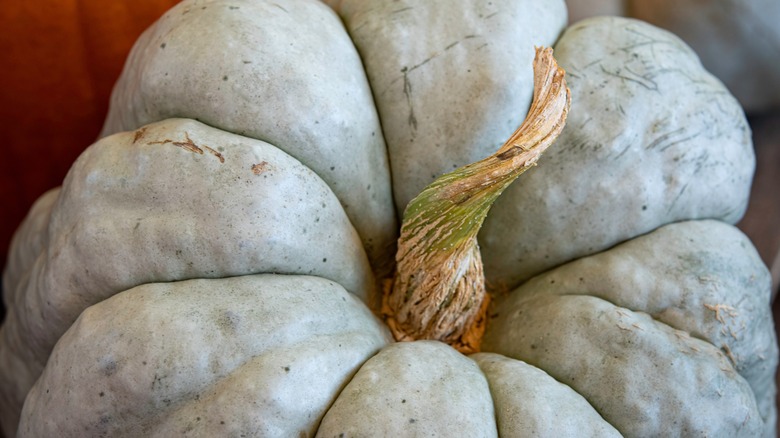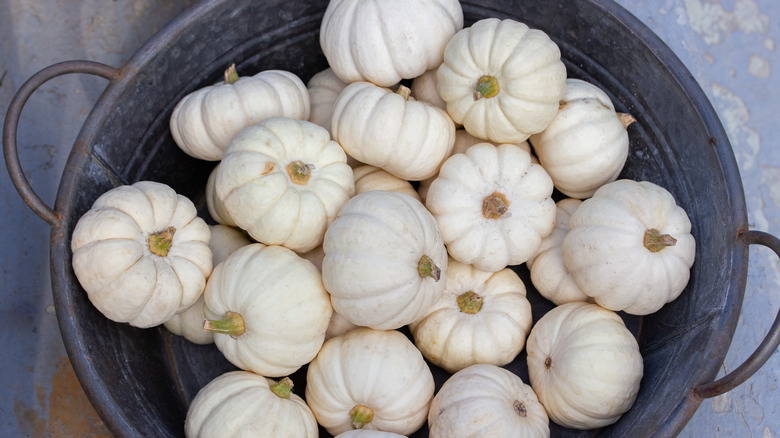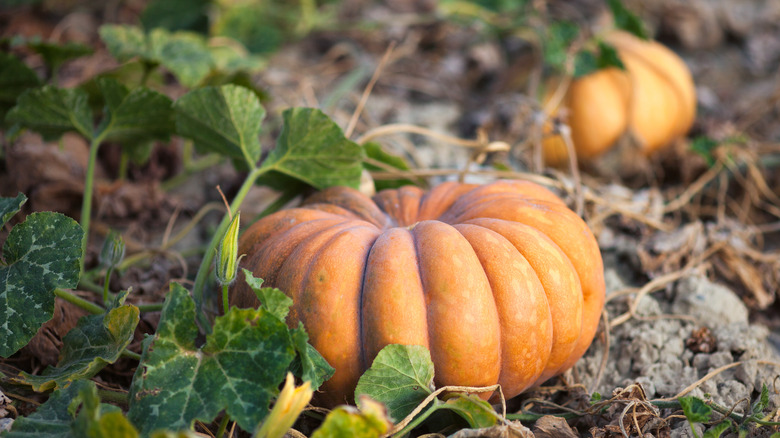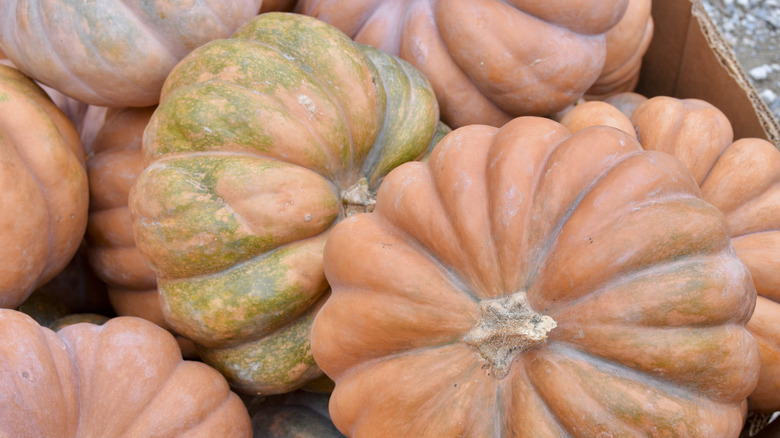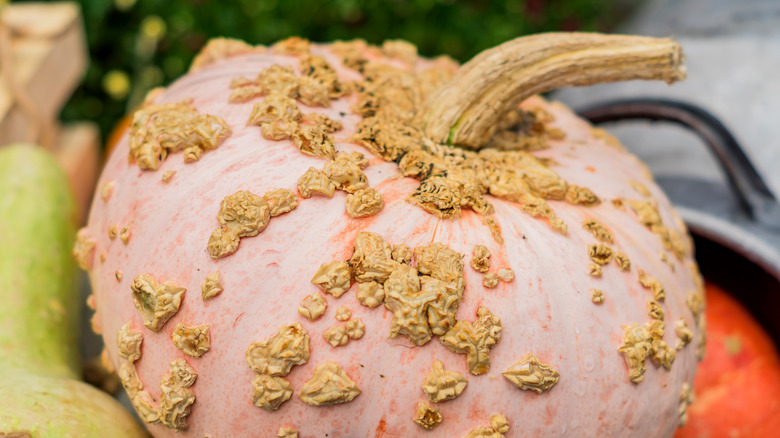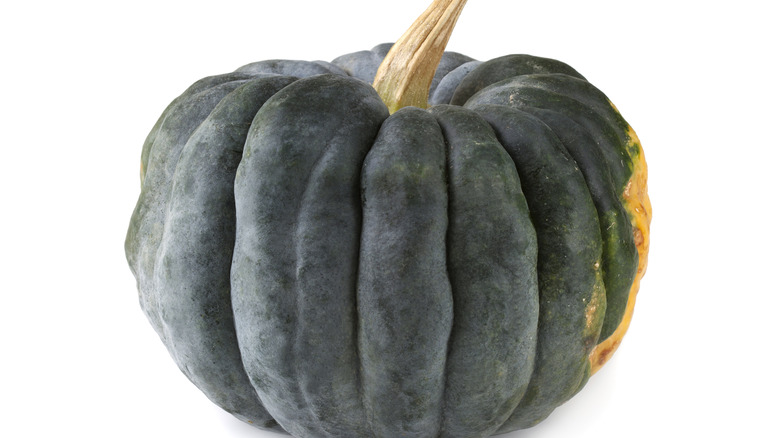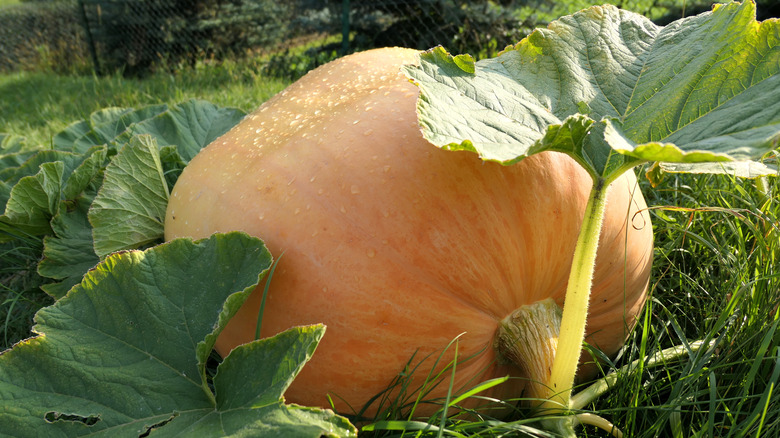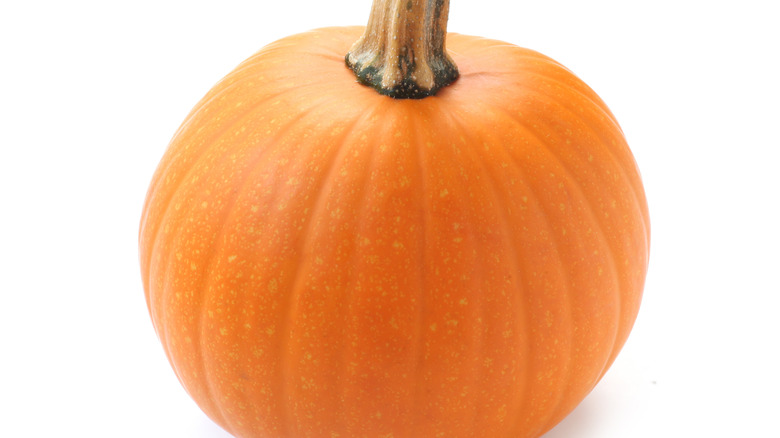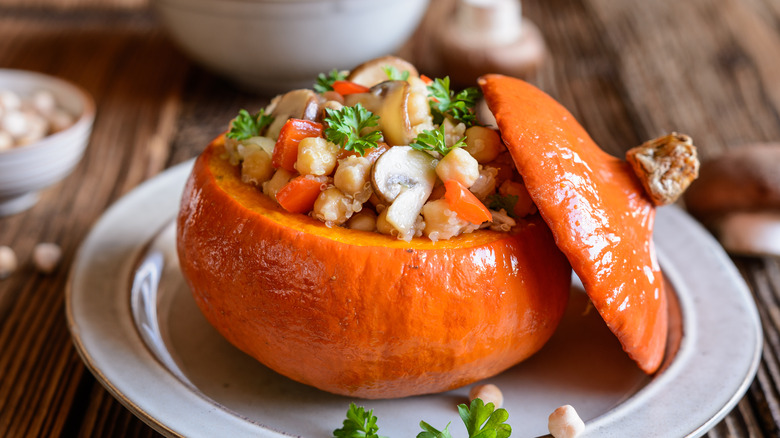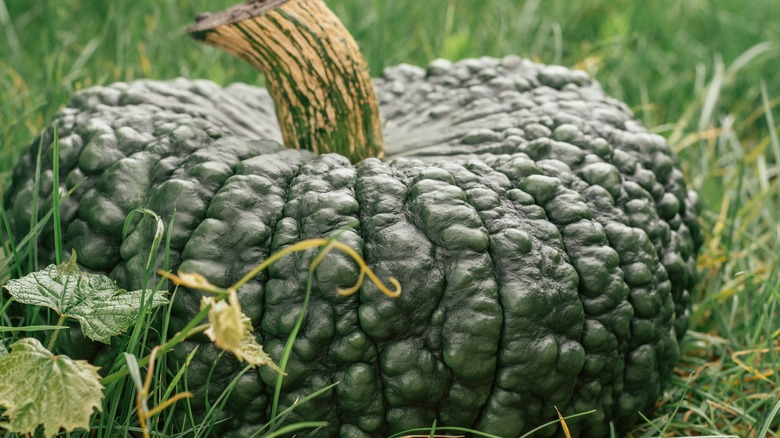12 Types Of Pumpkin And How To Use Them
Whether it be Halloween or Thanksgiving, pumpkin is undoubtedly the ultimate holiday vegetable. From whole pumpkins and carved pumpkins to pumpkin pies, puddings, cakes, cookies, candies, spiced pumpkin latte, and everything nice, there's nothing that you can't use the good ol' pumpkin for. The pumpkin supremacy doesn't end here, though. This orange-colored, round vegetable has even made its way into skincare products and scented candles.
However, that's not the only reason that Americans obsess over pumpkins. As per Medical News Today, pumpkins are a low-calorie vegetable full of essential vitamins and minerals. In fact, they are loaded with beta-carotene, a potent antioxidant that does wonders for your skin and eye health.
As popular as pumpkins are, you probably haven't heard of the countless pumpkins varieties out there. One size certainly does not fit all when it comes to pumpkins. Sugar pumpkins can't be used for jack-o-lanterns. Similarly, you can't expect to use an Atlantic giant in your pumpkin pie. This article will discuss the most popular pumpkin varieties and assorted tips on how you can use each of them.
Jack-Be-Little
Perfect for decorating your house for Halloween, Jack-be-little changes its color from uniform bottle green to bright orange on ripening. These dainty little fellows are 4 inches across and 2 inches tall (via The Garden Magazine).
According to Minneopa Orchards, Jack-be-little pumpkins were first grown in 1989. Since then, these miniature pumpkins have been planted widely in the US. If you're interested in a Halloween harvest, you can plant the seeds from late May to early June (May for Northern climates and June for Southern climates).
Even though Jack-be-littles are a primary decor item, they have culinary uses too. Mad About Macarons has outlined a fascinating stuffed mini pumpkin recipe. All you need to do is to cut and stuff these small dudes with a filling that includes cream, cheese, and some other vegetables. Moreover, you can use these cute little pumpkins in soups and even make candied pumpkins with them. However you use them, they taste delicious.
Rouge Vif d Etampes
We finally found the name of the popular "Cinderella pumpkin carriage." Yayyy! The sad part, though, is that you can't ride them. The happy part is that they will not ditch you after midnight.
You can use them in autumn decor or feel a little French by using them in your soup stock. The choice is yours. Rouge vif means bright red or vivid red in French, per Linguee, and Etampes is a French region where these pumpkins grow. Unlike the Jack-be-littles, these pumpkins are giants. According to Smart Gardener, they can weigh up to 10 kgs. Rare Seeds has noted that these pumpkins can weigh up to 20 lbs and are one of the oldest heirloom varieties grown since the 1880s.
Lohud has shared a delicious pasta recipe that uses rouge vif d Etampes as the base of the pasta sauce. Simply pick a pumpkin, cut, and deseed it. Roast, puree, and then mix some greens with the puree. Use the seasoned puree as your pasta sauce and enjoy the nutty flavor of the squash. If the variety is too wide for you, you can use it for a Jack-o-lantern.
Jarrahdale
Are you bored of growing the traditional orange pumpkin varieties in your garden? Give Jarrahdale a try. They will surprise you with their bluish-grey rind and exceptionally sweet flavor. While rouge vif d Etampes hail from France, these flat beauties are native to a small town called Jarrahdale in Western Australia. The variety is a cross between Hubbard squash and Cinderella pumpkin, so it has taken characteristics of both (via Home for the Harvest).
Gleaning the Field has noted that the jarrahdale pumpkin variety is a ribbed heirloom variety that weighs around 6-8 pounds. The flesh is golden and smells like cucumber. This is because pumpkins and cucumbers come from the same plant family, cucurbit. The Reid Home Stead advises growing these ornamental pumpkins to store and eat throughout the year. The non-stringy pulp of Jarrahdale is best for purees and stews. If you're not sure about consuming the pumpkins, they can be an excellent Jack-o-lantern carving option with a unique hue.
Baby Boo
Compact and white. That's how you can define a baby boo pumpkin. Previously, they were a rare variety in most of the U.S., but now you can spot them in the farmers' market. Although most of the pumpkin varieties are pretty old, baby boo or other white pumpkin varieties started late, in the early 21st century.
New Life on a Homestead has pointed out that the first white pumpkin variety was grown by a New Hampshire university professor, and its name was Moonshine. These are the smallest on the list till now, with 5-8 cm diameter and a half to one pound weight. Although their small size and cream white rind make them a perfect choice for fall decor, they have culinary uses too.
As per Specialty Produce, the baby boo pumpkin can be baked, steamed, or stewed. Whichever way you cook the orange pumpkins, you can use these small, eye-catching pumpkins the same way. Furthermore, you can hollow the inside and use the pumpkin as a sauce bowl or a dessert bowl as well. Best of all, you can even juice these baby boos.
Fairytale Pumpkin
If you want to see another variety that can turn into a Cinderella carriage, the fairytale pumpkin, also known as Castilla Squash in Spanish, is the one. They are huge, deeply ribbed, and have a gorgeous orange rind with a hint of brown to them. Unfortunately, while giving them their ornamental value, the orange skin is not edible because it's too tough.
Home for the Harvest has noted that although the variety is now widespread in France (called Mosquee de Provence), it originated from a pumpkin species in Central and South America. The name Mosquee de Provence comes from where it was first grown, Provence, a region that borders Italy.
Weighing between 15-20 pounds, these pumpkins turn from a green to a brownish orange on ripening. The ripened flesh has numerous culinary applications such as roasting, sautéing, baking, boiling, and grilling. If you don't want to cook it, you can eat raw pumpkin wedges just like you would a cantaloupe (via Specialty Produce).
Long Island Cheese Pumpkin
They don't taste like cheese, but they look like a cheese wheel, hence the name Cheese Pumpkin. Long Island is the Northeastern part of the U.S., where you can find these pumpkins with their cream-colored rinds and chunky builds.
A long island cheese pumpkin is undoubtedly the best for pumpkin pie. As per The travel, these pumpkins were awarded the best pumpkins for pies in the 1855 issue of Michigan farmer. You can expect this flattened, ribbed, muted orange-colored squash to weigh between 6-10 pounds, so either fall decor or pumpkin pie, the choice is yours (via Specialty Produce).
Hudson Valley Seed dove into the history of cultivation of these stocky dudes. The variety made its first commercial appearance on Long Island in 1807 and continued its popularity as a pie pumpkin among Long Island chefs until the mid-twentieth century. The pumpkin, however, disappeared and reappeared in 2012 when Ken Ettlinger started to grow the heirloom variety again. Now, this non-stringy delicious pumpkin variety is regaining its popularity in desserts and pies.
Galeux d'Eysines
If you ever see a pumpkin with warts, chances are you've encountered a Galeux d'Eysines. This heirloom pumpkin variety hails from the Eysines region of France and can grow up to 10-20 pounds. The distinctive part of its appearance is the lumps on the salmon-peach skin that form due to sugars from the flesh seeping into the rind (via Specialty Produce).
While the name might seem fancy, it literally translates to "embroidered with warts from Eysines." Earthwise Gardening noted an interesting observation regarding Galeux d'Eysines. Despite their attractive appearance, you cannot use these warted beauties for your jack-o-lanterns. You'll need to carve the skin with a sharp knife. However, the skin will regrow, forming other warts. So, forget the idea of carving them.
A Quota user has suggested removing the pumpkin's rind and then roasting, stewing, or grilling the non-stringy flesh for a delicious pumpkin meal. She also suggests not to seam or broil the pumpkin because the flesh is watery, resulting in a soggy mess.
Black Futsu
Another bumpy pumpkin variety on the list is Black Futsu. Unlike the Galeux d'Eysines, Black Futsu has dark-colored skin with almost the same rough appearance. However, there's a striking difference in the weight of the two varieties. Black Futsu attains a smaller size as compared to the Galeux d'Eysines.
This variety can grow up to 3-5 pounds and have a deep green skin that appears almost black when the Japanese squash is immature. However, on maturation, the skin changes hue first to a patchy yellow and finally to pale orange (via Specialty Produce). Depending on the size, a single Black Futsu can quite easily feed a family of four to five.
As per Garden Betty, Black Futsu can be stored long-term. If kept in a cool, dark place, they can stay put for up to six months. On the consumption part, you can cut the squash into wedges and bake them to make delicious pumpkin wedges, quite similar to sweet potato chips.
Atlantic Giant
Also known as the "World's Largest Pumpkin," these magnificent Atlantic Giants are generally the frontrunners in all pumpkin contests held worldwide. People have even turned them into boats for regattas.
The Dill's Atlantic Giant Pumpkin's average size is 500 pounds. However, if taken keen care of, they can grow up to a whopping 2,000 pounds. To achieve these gigantic sizes, the vines need ample exposure to sunlight and water. On ripening, the rind is light-orange, and the fruits grow on their sides (via Home for the Harvest).
Science News for Students has defined a surprising fact about these vast fruits to explain the growth of the Atlantic giants. When maturing, these giant pumpkins put on nearly 15 kgs per day. That makes them a favorite among pumpkin growing enthusiasts. Furthermore, despite popular opinion, Atlantic Giants are totally edible. You can cook the flesh and use it in soup, bread, and cookies.
Sugar Pumpkin
Not the best pumpkin variety for a jack-o-lantern pumpkin variety, sugar pumpkins, however, are incredible as freshly pureed pumpkins for your pumpkin cheesecakes.
Sugar pumpkins, unlike their name, do not have an overpowering sweet taste that leaves you craving a salty snack after having them. The taste is mildly sweet, but their extensive baking and cooking applications make them a chef's favorite.
Emery farms define the taste profile of sugar pumpkins as "sweet and savory" that can blend well with spices like ginger, nutmeg, cinnamon, and cloves. They have a list of suggestions to pair the delicious sugar pumpkin with. If you're making a dessert, you can choose maple syrup or molasses to enhance the pumpkin's flavor. For savory dishes, the sugar pumpkin's flavor shines with ingredients like mushrooms, wild rice, salty cheeses and herbs. Sugar pumpkins can also be stored long-term like Black Futsu. However, unlike Black Futsu, you can only store sugar pumpkins for a couple of weeks.
Hokkaido Pumpkin
Also known as Red Kuri squash, these beautiful un-ribbed pumpkins are one of the aesthetically pleasing pumpkin varieties. Hailing all the way from Japan, they are now plentiful in your local grocery stores and farmer's markets.
Their rinds are bright orangish-red and have a tear-drop shape resembling an onion. Weighing between three and seven pounds, these gorgeous pumpkins taste sweet with a nutty aftertaste (via Specialty Produce). Hokkaido pumpkins are among the smaller pumpkin varieties. As per Eat Smarter, the rinds of these fruits are edible, unlike most of the other pumpkin varieties on this list.
On the taste part, Hokkaido is the Japanese word for chestnut, so expect them to have a sweet, nutty taste that can blend well in soups, purees, and whatnot, per Feasting at Home. With their smooth skins, these beautiful pumpkins can be your next best bet for the Jack-o-lantern. Perhaps the best way to fully appreciate a Hokkaido pumpkin is to stuff it with vegetables and bake it.
Marina Di Chioggia
Perhaps the most interesting-looking pumpkin variety on this list is Marina Di Chioggia. Unlike the Atlantic giants or the fairytale pumpkins, Marina Di Chioggia has an intensely bumpy rind, even more uneven than the salmon peach-colored Galeux D'Eysines. The fruit is disc-shaped, with an average weight of 10-12 pounds. Just like the Galeux D'Eysines, Marina Di Chioggia, too, have warts due to sugar deposits seeping into the skin. While the former has a light color, the latter has a dark green to the greyish blue rind, which gets so tough on maturation that you can't puncture it with your nails (via Specialty Produce).
Belonging to an Italian origin, this distinct pumpkin variety is called Zucca Barucca and is grown in an Italian region called Chioggia. The fruit is a regular cultivar in Italy, and you can find it as a winter squash on fruit stands across the country.
Baker Creek Heirloom Seeds has aptly summed up the culinary uses of this Italian beauty. Growing in Italy since the 1600s, these warty dudes can become an ideal choice for a ravioli filling or a sweet-savory street snack when drizzled with olive oil and baked.
